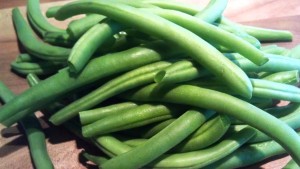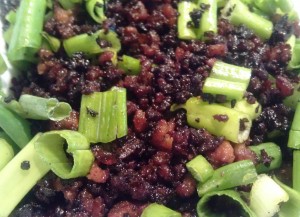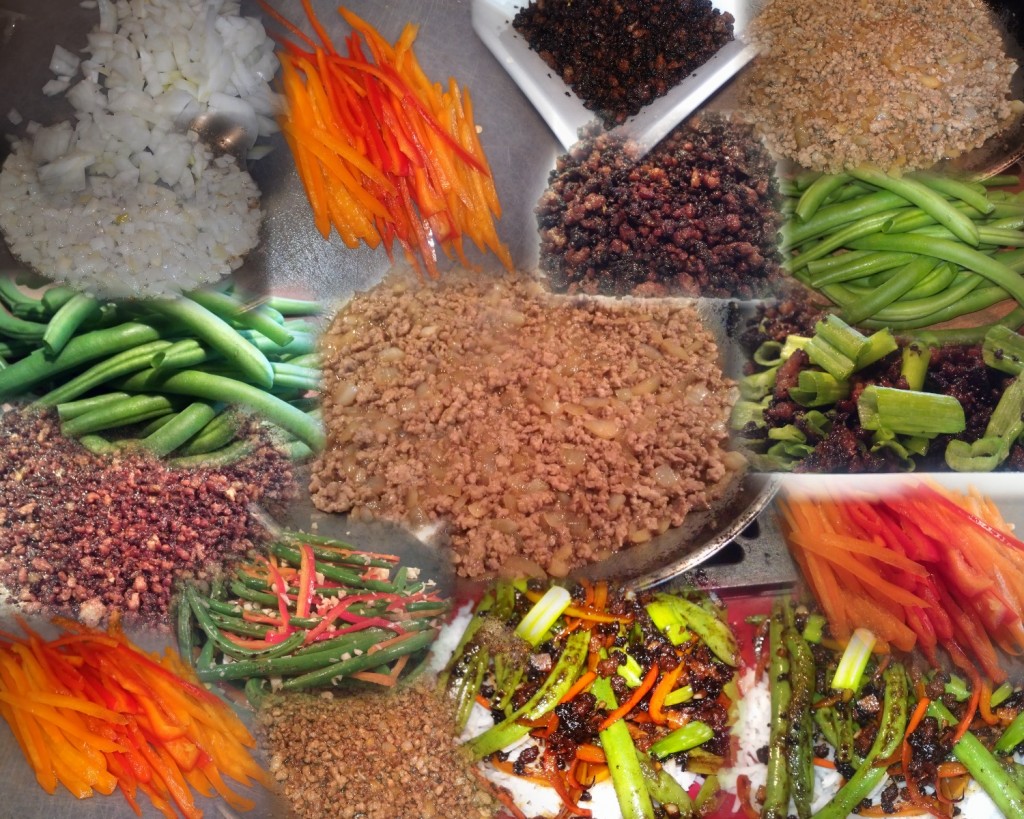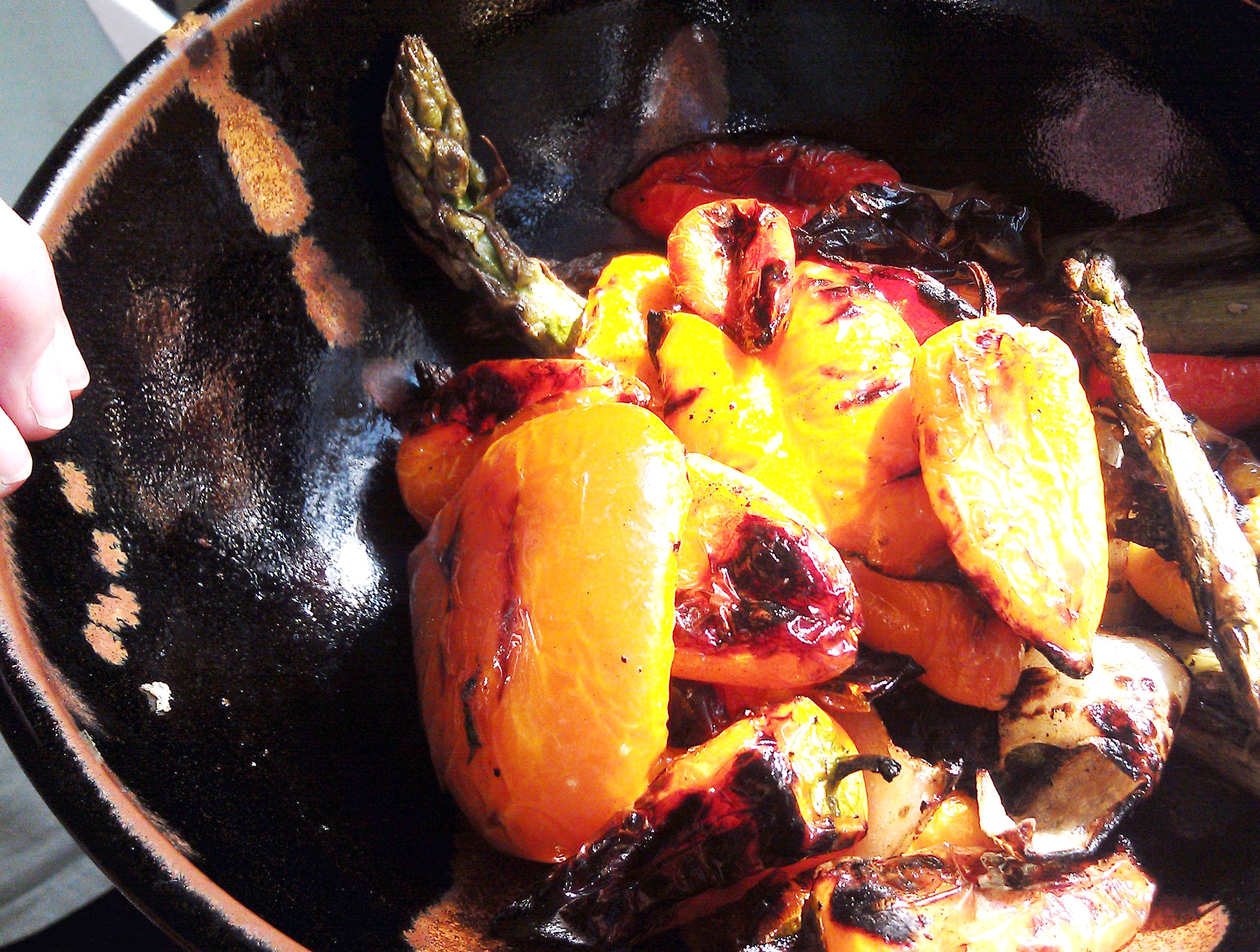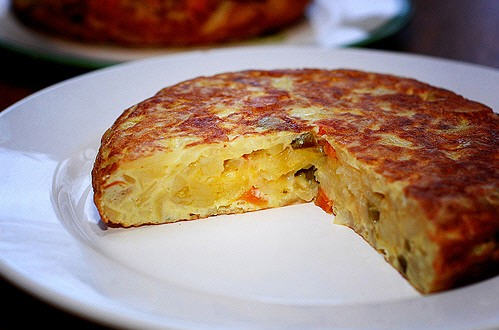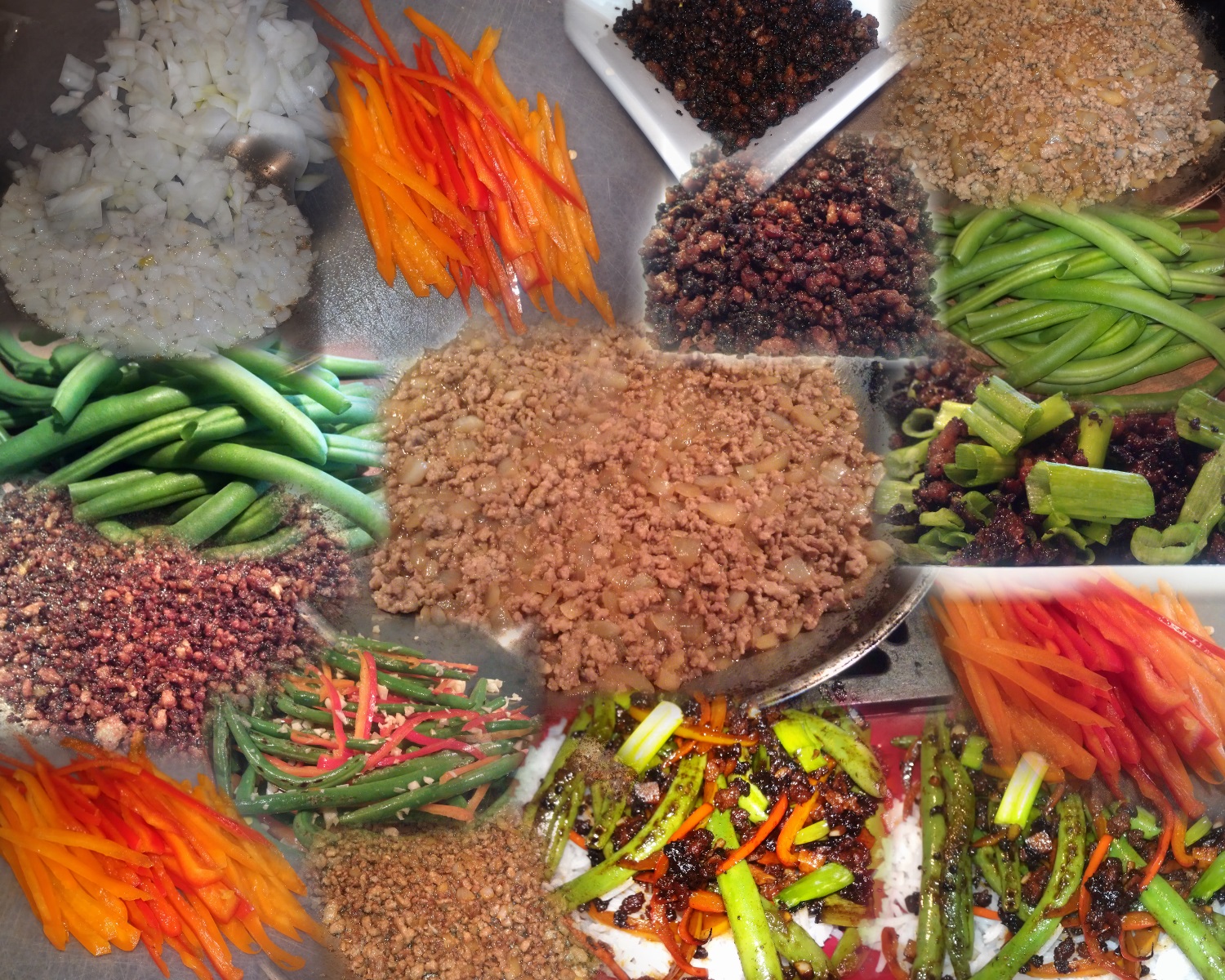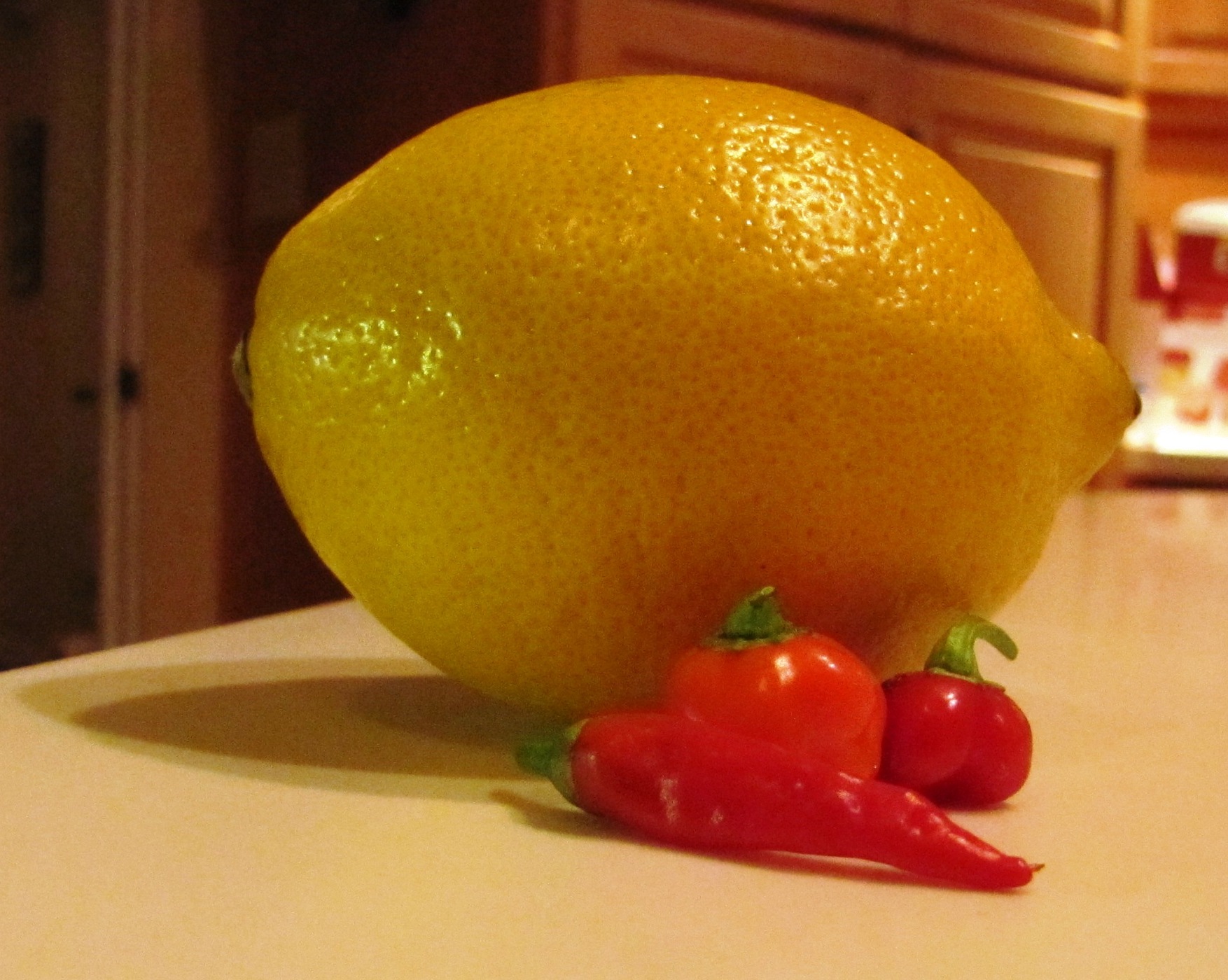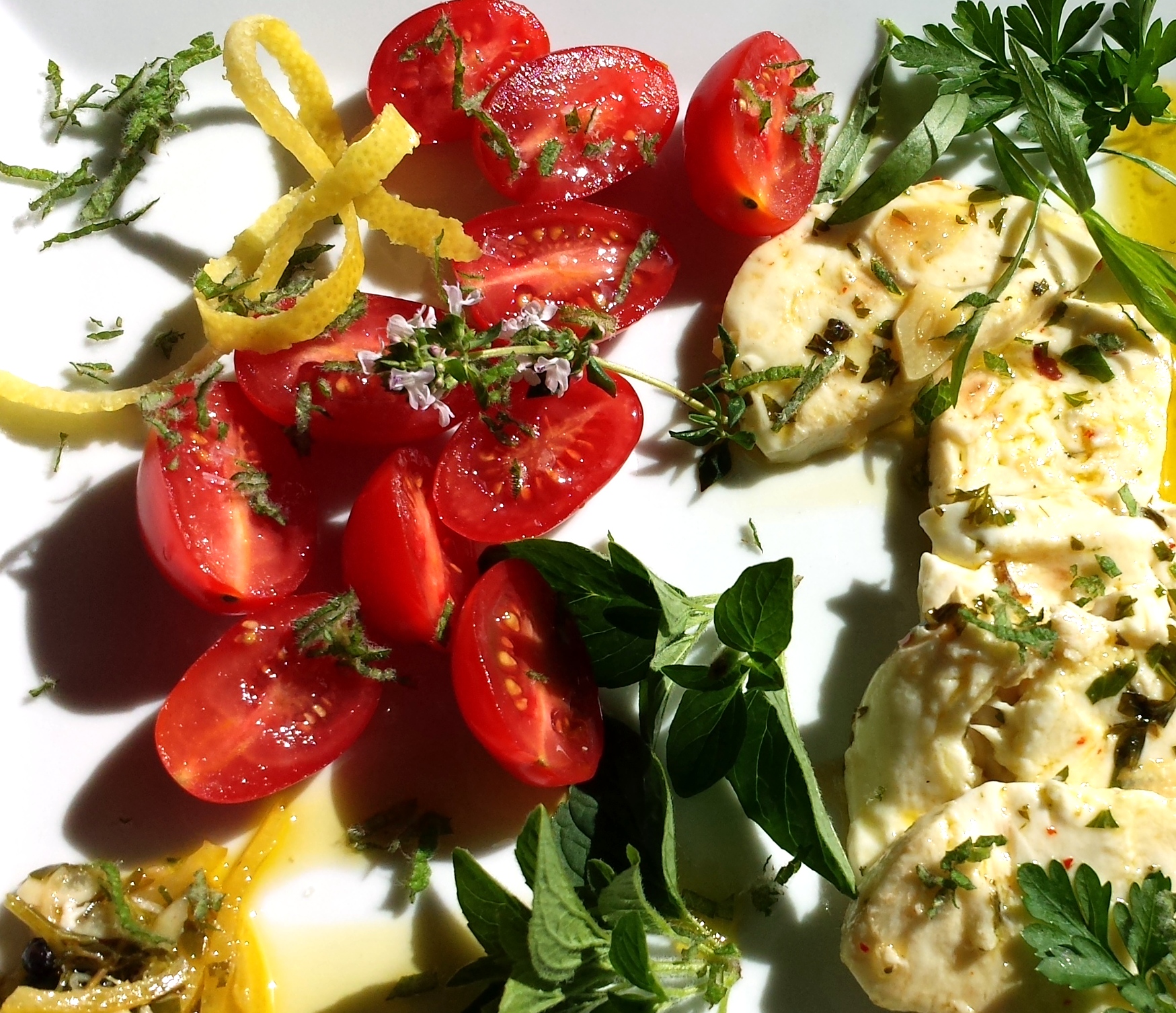I recently borrowed a large, coffee table cookbook from a friend – and Annette, I promise I will return it soon!! The book, Into the Vietnamese Kitchen, by Andrea Nguyen, is one of those wonderful cookbooks that offers not only dishes and recipes but core cooking techniques and pantry basics as well as rich insights into the cuisine of Vietnam.
It came quite serendipitously, as I’d just gotten a ton – OK, a bag full – of just picked, gorgeous green beans from “East of the Mountains”. When we say “East of the Mountains” here in the Skagit County / Salish Sea area, we mean the Cascade Mountains, east of which are the fertile irrigated valleys that produce much of the nation’s apples, hops, sweet cherries, hops and much more. And green beans – and peas – East of the Mountains is the largest lentil production area in the country!
We Love Stir Fried Green Beans
Many Asian cuisines have some type of stir fried or flash fried green bean dish. Often the dish has a bit of heat, a bit of aroma via herbs such as Thai basil and aromatics like garlic or shallot, a bit of darkness via soy or Kecap Manis (kind of an Indonesian soy based ketchup) or Nam Pla (fish sauce).
Our own version(s) of this dish usually go like this – get some great green beans, put ’em in the fridge. They are so beautiful that you are seduced, you buy them without necessarily thinking “what then will I do with these?”
And that’s OK, at least in our house, because we’re always up for a quick flash fried green beans-with-pork-herbs-soy-and lots of garlic. The general idea is to first heat a big wok. Now, by “heat”, I mean we turn the heat on under the wok and go off to play Words with Friends until the smoke detector goes off – it’s our timer. Then flash fry the green beans in just a T of oil, a little garlic, some soy and some pork until everything is seared and tasty and the juice from the beans + the added liquids makes a lovely light sauce. Serve over rice. The problem is that it’s tough to properly cook the beans and the pork together and it’s inconvenient to cook them separately. One great solution is to use Vietnamese Caramelized Pork with your flash fried green beans.
OK, But What About the Cookbook – and the Recipes??
In reading this cookbook, I came across a wonderful, foundational recipe – one of those recipes that lets you make something used in a wide variety of dishes. A pantry recipe. Like a really great recipe for whipped cream using powdered sugar and maple syrup that you can use in a wide variety of dishes. Only pork. And not just any pork. Caramelized pork, just this side of carbon and so very good.
As I mentioned earlier, the problem with making green beans and pork is that it’s difficult to sear the beans and cook the pork properly in one wok or at least at the same time. The question is how to get that dark, flavorful slightly-crusted-and-smoky flavor in the pork without searing the beans beyond recognition. The answer is:
Vietnamese Caramelized Pork, adapted from Andrea Nguyen’s Into the Vietnamese Kitchen
We love pork cracklings. And, well, BACON! But the Vietnamese have gone us one better with Caramelized Pork – it’s the essence of crispy, slightly smoky pork with just a hint of sweetness, a touch of savory and a bit of salt. It’s the perfect accompaniment to many dishes and it keeps in the fridge for at least a week, so you can easily make it ahead.
Ingredients for 4-6 servings
- 1-1/4 lb. pork, either ground or cut into small bits
- 1/2 C. sugar
- 3-4 TB neutral cooking oil (peanut or safflower work here, just no flavored oils or aromatic oils like olive)
- 3 TB. nam pla (fish sauce)
- 2 TB. minced garlic
- Splash sesame oil
- (optional, but good) 1 TB light soy
- 2-3 green onions sliced into 1/2″ slices, mostly green parts, if a few white parts slip into the mix, it’s OK, but try for mostly green
- Salt, pepper to taste
Preparation
Put the oil and sugar in a heavy bottom sauté pan over medium-high heat until the sugar and heat, stirring, until the sugar begins to turn a nice amber-brown color. The sugar is now caramelizing. Remove the pan from the heat, stir in the garlic, and stir fry for 30 seconds or so, until the garlic is quite fragrant. Be Careful!! The caramel is extremely hot. This is not a dish to cook in short sleeves.
Put the pan back on the heat, add the pork, the nam pla, the sesame oil, and (optionally) the soy. The added liquids plus the liquid that the pork gives off as it cooks, will create a sauce with the caramel. Don’t worry if the caramel “seizes” or turns into a solid lump when you first add the meat and liquids, it will re-dissolve shortly as you stir. Did I mention to: Be Careful!! The caramel is extremely hot. This is not a dish to cook in short sleeves.
Stir fry the meat for a few minutes, watching the heat carefully so as not to burn, then turn the heat down a bit and cook until most of the sauce is absorbed, the meat begins to actually fry, and, after a few minutes, takes on a lovely reddish brown hue – the idea is to cook the meat and caramel just a few degrees South of carbon, the reddish-brown hue is your cue that it is perfectly done!
When the meat is done, add the green onions and toss them until they just wilt – about 30 seconds. Take the pan off the heat. You’re done. You’ve made Vietnamese Caramelized Pork! When it cools a bit, taste and add salt and pepper to taste, it likely won’t need much of either.
You can optionally add thinly sliced hot chilies to the meat after removing it from the heat, if you like, as well as a bit of minced ginger, but these are entirely optional – the base recipe is filled with flavor – sweet and savory.
Don’t Want to Have to Make Caramel? It’s not that tough to make caramel, but it does require some work. You can make a pretty decent replica of this recipe – it will taste a little different, but still delicious and will have the same flavor profile of sweet and savory – without making caramel, as follows.
Note: You will need to have a bottle of Kecap Manis – the wonderful Indonesian dark and sweet soy-based ketchup-like sauce – on hand, as well as soy and sugar and a small yellow onion.
Alternate Preparation Method
In a large sauté pan, heat 3-4 T. neutral oil over medium-high heat. When it’s hot, add a small yellow onion, in medium dice and fry, stirring occasionally, until the onion is soft and translucent, about 3-5 minutes.
Add the pork, 3 T. kecap manis, 1 T. soy, 1 tsp. white vinegar, 2 T. nam pla fish sauce, splash sesame oil and sauté, stirring and breaking up any chunks. Continue to cook, stirring and mixing regularly, until the liquids have cooked down and the meat begins to actually fry. Continue to cook, stirring, until the meat begins to take on a darkish, almost deep red hue, this should take about 12-15 minutes. When the meat is close, stir in the minced garlic and fry for another minute or until the garlic is quite fragrant.
Remove the pan from the heat and stir in 2 onions, green parts only, sliced into 1/2″ pieces. Let the mixture cool a bit, then taste and add salt and pepper to taste. This type of preparation gives you many of the same flavor elements that the traditional caramelization offers. I strongly suggest you try making the traditional caramelized pork at least once – you’ll be hooked!
You can use your Caramelized Pork in a wide variety of dishes: By itself, with cooked veggies, such as green beans or asparagus, as a garnish for soups, over rice, or in many other dishes such as:
Flash Fried Green Beans with Caramelized Pork – At Last!
Ingredients for 4-6 servings
- 1-1/4 lb. freshest possible green beans, trimmed
- (Optional) 1/2 sweet red Bell pepper, trimmed and cut into 1/4 inch slices.
- 2 T. minced garlic
- 2 T. light soy sauce (“regular” soy sauce)
- 1 T. dark soy sauce. This is a thick, slightly sweet type of soy, you can find it at most larger supermarkets, specialty stores and online here: Dark Soy
- 1/4 C. hot water
- Salt, pepper to taste
- 1/2 lb. Vietnamese Caramelized Pork (from recipe above)
Preparation
Put a large wok over your biggest burner and heat the wok. Heat it to within an inch of its life, heat it until it’s almost glowing. Give it at least five minutes over the heat, ten is better!
Add 1-1/2 T of a neutral oil (peanut, safflower, etc., nothing with a pronounced flavor) and swirl it in the wok until it’s just shy of smoking. It may even smoke a bit.
Add the trimmed green beans. If your range doesn’t have a really large burner, you can add the beans in two parts, to avoid cooling the wok down too much. Add the first part, it will begin to sizzle and steam immediately. Stir fry for just a moment, then add the second part and keep stir frying.
Tip: You’ll be stir frying the beans for 5-6 minutes. Several times during the process, let them rest for 15-20 seconds, just sitting on the very hot wok without being stirred. That will help bring out a little bit of the “char” – they’ll taste slightly smoky and quite delicious!
When the beans are beginning to develop little char spots here and there, add the (optional) sliced sweet red pepper, the minced garlic and stir fry for another minute or until the garlic is quite fragrant and some of it is just beginning to color.
Add your prepared Vietnamese Caramelized Pork and mix it in thoroughly with the green bean / garlic mixture. Stir fry for a minute or so – the pork is already cooked, you just want to heat it up and marry it with the green beans.
Add the soy sauces and water and stir, reducing the heat, to make a sauce. Cook for a minute or so more until the sauce thickens slightly.
You’re done!! Remove from the heat and serve over plain hot rice. You should have enough delicious liquid from the pork and the liquid ingredients you added to the green beans to make a sauce for the rice, if you don’t, add just a tiny bit more very hot water. Taste and add salt, pepper to your liking.
Serve over a bed of plain cooked rice. We like basmati, but plain medium grain white rice is also good. I haven’t yet tried this over brown rice, but I think it would play very nicely with brown rice’s nuttier rich flavor.
Did you notice? You used less pork than you made! So you have leftovers!!
You can use your Vietnamese Caramelized Pork wherever you’d like a sweet, savory, and entirely delicious addition to vegetable dishes, by itself over rice (or perhaps even rice noodles!), or wherever your culinary imagination takes you. Let me know if you try it out!



